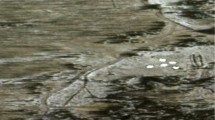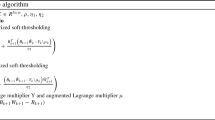Abstract
An important application in remote sensing using hyperspectral imaging system is the detection of anomalies in a large background in real-time. A basic anomaly detector for hyperspectral imagery that performs reasonaly well is the RX detector. In practice, the subspace RX (SSRX) detector which deletes the clutter subspace has been known to perform better than the RX detector. In this paper an anomaly detector that can do better than the SSRX detector without having to delete the clutter subspace is developed. The anomaly detector partials out the effect of the clutter subspace by predicting the background using a linear combination of the clutter subspace. The Mahalanobis distance of the resulting residual is defined as the anomaly detector. The coefficients of the linear combination are chosen to maximize a criterion based on squared correlation. The experimental results are obtained by implementing the anomaly detector as a global anomaly detector in unsupervised mode with background statistics computed from hyperspectral data cubes with wavelengths in the visible and near-infrared range. The results show that the anomaly detector has a better performance than the SSRX detector. In conclusion, the anomaly detector that is based on partialling out can achieve better performance than the conventional anomaly detectors.

























Similar content being viewed by others
References
Schaum AP (2007) Hyperspectral anomaly detection beyond RX. In: Proceeding of 13th SPIE conference on algorithms and technologies for multispectral, hyperspectral, and ultraspectral imagery, vol 6565, p 656502
Stein DWJ, Beaven SG, Hoff LE, Winter EM, Schaum AP, Stocker AD (2002) Anomaly detection from hyperspectral imagery. IEEE Signal Process Mag 19:58–69
Schaum AP (2006) Hyperspectral detection algorithms: from old ideas to operational concepts to next generation. In: Proceeding of 12th SPIE conference on algorithms and technologies for multispectral, hyperspectral, and ultraspectral imagery, vol 6233, p 623305
Horwitz HM, Nalepka RF, Hyde PD, Morgenstern JP (1971) Estimating the proportions of objects within a single resolution element of a multispectral sensor. In: Proceeding of 7th international symposium on remote sensing of environment (Ann Arbor, MI), pp 1307–1320
Stocker A, Schaum A (1997) Application of stochastic mixing models to hyperspectral detection problems. In: Proceeding of 3rd SPIE conference on algorithms and technologies for multispectral, hyperspectral, and ultraspectral imagery, vol 3071, pp 47–60
Stein (2003) Material identification and classification in hyperspectral imagery using the normal mixture model. In: Proceeding of 9th SPIE conference on algorithms and technologies for multispectral, hyperspectral, and ultraspectral imagery, vol 5093, pp 559–568
Grossman JM, Bowles J, Haas D, Antoniades JA, Grunes MR, Palmadesso P, Gillis D, Tsang KY, Baumback M, Daniel M, Fisher J, Triandaf T (1998) Hyperspectral analysis and target detection system for the adaptive spectral reconnaissance program (ASRP). In: Proceeding of 4th SPIE conference on algorithms and technologies for multispectral, hyperspectral, and ultraspectral imagery, vol 3372, pp 2–13
Duran O, Petrou M (2009) Spectral unmixing with negative and superunity abundances for subpixel anomaly detection. IEEE Trans Geosci Remote Sensing Lett 6(1):152–156
Kwon H, Nasrabadi NM, Kernel RX (2005) A new nonlinear anomaly detector. In: Proceeding of 11th SPIE conference on algorithms and technologies for multispectral, hyperspectral, and ultraspectral imagery, vol 5806, p 35
Scholkopf B, Smola A, Muller KR (1998) Nonlinear component analysis as a kernel eigenvalue problem. Neural Comput 10(5):1299–1319
Lo E, Ingram J (2008) Hyperspectral anomaly detection based on minimum generalized variance method. In: Proceeding of 14th SPIE conference on algorithms and technologies for multispectral, hyperspectral, and ultraspectral imagery, vol 6966, p 696603
Rousseeuw PJ, Driessen KV (1999) Fast algorithm for the minimum covariance determinant estimator. Technometrics 41(3):212–223
Barnett V, Lewis T (1998)Outliers in statistical data, 3rd edn. Wiley, New York
Bernhardt M, Heather J, Watkins O (2006) Hyperspectral clutter statistics, generative models, and anomaly detection. In: Proceeding of 12th SPIE conference on algorithms and technologies for multispectral, hyperspectral, and ultraspectral imagery, vol 6233, p 623321
Juan J, Prieto FJ (2001) Using angles to identify concentrated multivariate outliers. Technometrics 43(3):311–322
Reed IS, Yu X (1990) Adaptive multiple-band CFAR detection of an optical pattern with unknown spectral distribution. IEEE Trans Acoustics Speech Signal Process 38:1760–1770
Schaum A, Stocker A (2002) Joint hyperspectral subspace detection derived from a Bayesian likelihood ratio test. In: Proceeding of 8th SPIE conference on algorithms and technologies for multispectral, hyperspectral, and ultraspectral imagery, vol 4725, pp 225–233
Chang C, Chiang S (2002) Anomaly detection and classification for hyperspectral imagery. IEEE Trans Geosci Remote Sensing 40:1314–1325
Lo E (2009) Outlier detection algorithm for hyperspectral imagery based on conditioning on background subspace. In: Proceeding of AIP 2nd global conference on power control and optimization, vol 1159, pp 212–214
Lo E, Schaum A (2009) A hyperspectral anomaly detector based on partialing out a clutter subspace. In: Proceeding of 15th SPIE conference on algorithms and technologies for multispectral, hyperspectral, and ultraspectral imagery, vol 7334, p 733404
Morrison DF (1976) Multivariate statistical method, 2nd edn. McGraw Hill, New York
Anderson TW (2003) An introduction to multivariate statistical analysis, 3rd edn. Wiley Interscience, New York
Kerekes JP, Snyder DK (2010) Unresolved target detection blind test project overview. In: Proceeding of 16th SPIE conference on algorithms and technologies for multispectral, hyperspectral, and ultraspectral imagery, vol 7695, p 769521
Acknowledgments
The author wishes to thank the US Naval Research Laboratory, Washington, DC for funding and data and the Rochester Institute of Technology for the data.
Author information
Authors and Affiliations
Corresponding author
Rights and permissions
About this article
Cite this article
Lo, E. Maximized subspace model for hyperspectral anomaly detection. Pattern Anal Applic 15, 225–235 (2012). https://doi.org/10.1007/s10044-011-0206-1
Received:
Accepted:
Published:
Issue Date:
DOI: https://doi.org/10.1007/s10044-011-0206-1




